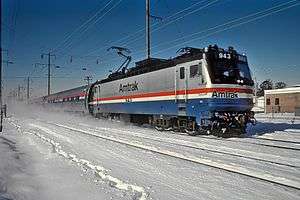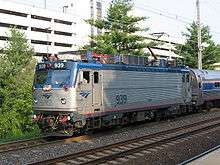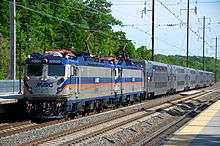EMD AEM-7
| EMD AEM-7 | |||||||||||||||||||||||||||||||||||||
|---|---|---|---|---|---|---|---|---|---|---|---|---|---|---|---|---|---|---|---|---|---|---|---|---|---|---|---|---|---|---|---|---|---|---|---|---|---|
 Amtrak AEM-7 No. 943 with a Metroliner at Seabrook, Maryland, in 1987 | |||||||||||||||||||||||||||||||||||||
| |||||||||||||||||||||||||||||||||||||
| |||||||||||||||||||||||||||||||||||||
| |||||||||||||||||||||||||||||||||||||
| |||||||||||||||||||||||||||||||||||||
| [1][2] | |||||||||||||||||||||||||||||||||||||
The AEM-7 is a twin-cab four-axle 7,000 hp (5.2 MW) B-B electric locomotive built by Electro-Motive Division (EMD) and ASEA between 1978 and 1988. The locomotive was a derivative of the Swedish SJ Rc4 designed for passenger service in the United States. The primary customer was Amtrak, which bought 54 for use on the Northeast Corridor and Keystone Corridor. Two commuter operators, MARC and SEPTA, also purchased locomotives, for a total of 65.
Amtrak ordered the AEM-7 after the failure of the GE E60 locomotive. The first locomotives entered service in 1980 and were an immediate success, ending a decade of uncertainty on the Northeast Corridor. In the late 1990s, Amtrak rebuilt 29 of its locomotives from DC to AC traction. The locomotives continued operating through the arrival of the final Siemens ACS-64 in June 2016. MARC retired its fleet in April 2017 in favor of diesel operation; SEPTA expects to replace its fleet with ACS-64 locomotives in October 2018.
Background

Amtrak assumed control of almost all private sector intercity passenger rail service in the United States on May 1, 1971, with a mandate to reverse decades of decline. Amtrak retained approximately 184 of the 440 trains which had run the day before.[3] To operate these trains, Amtrak inherited a fleet of 300 locomotives (electric and diesel) and 1190 passenger cars, most of which dated from the 1940s–1950s.[4]
Operation on the electrified portion of the Northeast Corridor was split between the Budd Metroliner electric multiple units and PRR GG1 locomotives. The latter were over 35 years old and restricted to 85 mph (137 km/h).[5] Amtrak sought a replacement, but no United States manufacturer offered an electric passenger locomotive. Importing and adapting a European locomotive would require a three-year lead time. With few other options, Amtrak turned to GE to adapt the E60C freight locomotive for passenger service.[6] GE delivered two models, the E60CP and the E60CH. However, the locomotives proved unsuitable for speeds above 90 mph (145 km/h), leaving Amtrak once again in need of a permanent solution.[7]
Amtrak then turned to existing European high-speed designs, and two were brought over for trials in 1976–77: the Swedish Rc4 (numbered X995), and the French CC 21000 (X996).[8] Amtrak favored the Swedish design, which became the basis for the AEM-7.[9]
Design
| AEM-7 | PRR GG1 | GE E60 | |
|---|---|---|---|
| Length | 51 ft 1 25⁄32 in (15.59 m)[10] | 79 feet 6 inches (24.23 m)[11] | 71 ft 3 in (21.7 m)[12] |
| Weight[13] | 101 short tons (90 long tons; 92 t) | 193.5 short tons (173 long tons; 176 t) | 237.5 short tons (212 long tons; 215 t) |

The AEM-7 was far smaller than its predecessors, the PRR GG1 and the GE E60. It measured 51 ft 1 25⁄32 in (15.59 m) long by 10 ft 2 in (3.10 m) wide, and stood 14 ft 9.5 in (4.51 m) tall,[14] a decrease in length of over 20 ft (6.1 m).[11][12] The AEM-7's weight was half that of the E60CP or the GG1.[13][11] On its introduction it was the "smallest and lightest high horsepower locomotive in North America."[15] The Budd Company manufactured the carbodies for the initial Amtrak order, the Austrian firm Simmering-Graz-Pauker for the MARC and SEPTA orders.[16]
Reflecting the varied electrification schemes on the Northeast Corridor the locomotives could operate at three different voltages: 11 kV 25 Hz AC, 12.5 kV 60 Hz AC and 25 kV 60 Hz.[17] A pair of Faiveley DS-11 two-stage pantographs, one at each end of the locomotive, collected power from the overhead catenary wire.[18] Thyristor converters stepped down the high-voltage AC to provide DC power at a much lower voltage to four traction motors, one per axle.[19] As built the AEM-7 was rated at 7,000 hp (5.2 MW), with a starting tractive effort of 51,710 lbf (230 kN) and a continuous tractive effort of 28,100 lbf (125 kN). Its maximum speed was 125 miles per hour (201.2 km/h).[15] A separate static converter supplied 500 kW 480 V head-end power (HEP) for passenger comfort.[20] This was sufficient to supply heating, lighting, and other electrical needs in 8-10 Amfleet cars.[21]
AEM-7AC
The rebuilt AEM-7ACs used AC traction instead of DC traction. The power modules used water-cooled insulated-gate bipolar transistor (IGBT) technology and provided about 5,000 kilowatts (6,700 horsepower) of traction power plus 1,000 kilowatts (1,300 horsepower) of HEP, twice the HEP capacity of the original DC units. The 6 FXA 5856 traction motors, from Alstom's ONIX family of propulsion components, had a maximum rating of 1,250–1,275 kilowatts (1,676–1,710 horsepower) each and a continuous rating of 1,080 kilowatts (1,450 horsepower). The remanufactured AEM-7ACs were the world's first passenger locomotives to incorporate IGBT technology.[1][22]
History

Amtrak planned a fleet of 53 locomotives, with an estimated cost of $137.5 million.[23] Limited funding hampered that plan, but in September 1977 Amtrak proceeded with a plan to buy 30 locomotives for $77.8 million. Five companies bid on the contract: General Motors' Electro-Motive Division (EMD)/ASEA, Morrison-Knudsen/Alsthom, Brown Boveri, Siemens-Krauss-Maffei, and AEG-Telefunken-Krauss-Maffei.[24] Amtrak awarded the contract to EMD/ASEA in January 1978.[25] It ordered 17 more locomotives in February 1980, bringing the total to 47.[26]
Revenue service began on May 9, 1980, when No. 901 departed Washington Union Station with a Metroliner service.[27] The Swedish influence led to the nickname "Meatball", after Swedish meatballs. Railfans nicknamed the boxy locomotives "toasters".[28] Between 1980 and 1982, 47 AEM-7s (Nos. 900–946) went into service.[29] Amtrak retired the last of its PRR GG1s on May 1, 1981,[30] while most of the GE E60s were sold to other operators.[31] The new locomotives swiftly proved themselves; Car and Locomotive Cyclopedia stated that no new locomotive since the New York Central Hudson had "such an impact on speeds and schedule performance."[32]
This strong performance led to further orders. Amtrak added seven more locomotives in 1987, delivered in 1988, for a total of 54.[29] Two commuter operators in the Northeast ordered AEM-7s. MARC ordered four in 1986 for use on its Penn Line service on the Northeast Corridor between Washington, D.C. and Perryville, Maryland.[33] The Southeastern Pennsylvania Transportation Authority (SEPTA) ordered seven in 1987.[34] Amtrak also used the AEM-7s to handle the Keystone Service on the Keystone Corridor between Harrisburg and Philadelphia as the Budd Metroliners, displaced from the Northeast Corridor, reached the end of their service lives.[35]
Refurbishment
In 1999, Amtrak and Alstom began a remanufacturing program for Amtrak's AEM-7s. Alstom supplied AC propulsion equipment, electrical cabinets, transformers, HEP, and cab displays. The rebuild provided Amtrak with locomotives that had improved high end tractive effort and performance with longer trains. Amtrak workers performed the overhauls under Alstom supervision at Amtrak's shop in Wilmington, Delaware.[36] These remanufactured AEM-7s were designated AEM-7AC. Between 1999 and 2002, Amtrak rebuilt 29 of its AEM-7s.[37]
Retirement
As the locomotives passed thirty years of service their operators made plans for replacements. In 2010, Amtrak ordered 70 Siemens ACS-64 locomotives to replace both the AEM-7s and the newer but unreliable Bombardier/Alstom HHP-8s.[38] The ACS-64s began entering revenue service in February 2014.[39] The last two active AEM-7s, Nos. 942 and 946, made their final run on June 18, 2016, on a special farewell excursion that ran between Washington, D.C. and Philadelphia.[40]
While Amtrak was replacing its AEM-7s, MARC initially decided in 2013 to phase out its electric operations on the Penn Line altogether and retire both its AEM-7 and Bombardier–Alstom HHP-8 locomotives,[41] but the railroad instead started a refurbishment program for its HHP-8s in 2017.[42] As of September 2017, the first HHP-8 reconditioned under this program had been delivered and was undergoing successful testing.[43] MARC selected the Siemens Charger diesel locomotive as the replacement for its AEM-7 fleet in 2015.[44] The last of the MARC AEM-7s were retired by April 2017, with the Chargers expected to enter service by January 2018.[42] SEPTA will continue to use electric traction, replacing its seven AEM-7s and lone ABB ALP-44, an improved AEM-7, with the ACS-64 in October 2018.[45][46][47]
Preservation
Two locomotives, ex-Amtrak Nos. 928 and 942, were moved to the Transportation Technology Center, Inc. in July 2017.[48]
Caltrain, which operates commuter trains in the San Francisco Bay Area, showed interest in purchasing several retired Amtrak AEM-7s to test their electrification system once completed. The units would also serve as backup power for EMU cars.[49] On June 7, 2018, Caltrain staff recommended that two contracts be awarded for a total of approximately $600,000: one to purchase two AEM-7ACs from Mitsui & Co, and the other to Amtrak for refurbishment, training, and transportation to the Caltrain maintenance facility in San Jose.[50]
Two units have been preserved: ex-Amtrak Nos. 915 at the Railroad Museum of Pennsylvania,[51] and 945 at the Illinois Railway Museum.[52]
See also
Notes
- 1 2 "ALSTOM Transport - AEM7 locomotives, USA". alstom.com. Archived from the original on March 25, 2006.
- ↑ "Typbeskrivningar - AEM7 exporterade till Amtrak m fl". passagen.se. Archived from the original on May 24, 2002.
- ↑ Kelly, John (June 5, 2001). "Amtrak's beginnings". Classic Trains. Retrieved September 13, 2016.
- ↑ Simon & Warner 2011, p. 108
- ↑ GAO 1976, p. 29
- ↑ GAO 1976, p. 30
- ↑ USDOT 1978, p. 71
- ↑ Tillier, Clem. "Amtrak's X996". Amtrak Historical Society.
- ↑ Cudahy 2002, pp. 85–86
- ↑ Ephraim 1983, p. 51
- 1 2 3 Abendschein 1983, p. 5
- 1 2 General Electric. "Operating Manual - Class E-60CP Thyristor Type Locomotive (Ref: GEJ-5688B)". Bob Kise's Railroad Picture Archives (pdf). Archived from the original on February 2, 2016. Retrieved January 28, 2016.
- 1 2 "Digging into the Archives: The AEM-7 Locomotive". Amtrak. July 19, 2013. Retrieved July 9, 2017.
- ↑ Ephraim 1983, p. 51
- 1 2 Ephraim 1982, p. 1
- ↑ Trains 1986, p. 13
- ↑ Ephraim 1982, p. 5
- ↑ NTSB 1985, p. 15
- ↑ Ephraim 1982, pp. 6–7
- ↑ Ephraim 1982, p. 3
- ↑ Solomon 2014, p. 309
- ↑ Debruyne, Marc. "High power IGBT traction drives" (PDF). Alstom. p. 11. Archived from the original (PDF) on August 4, 2014.
- ↑ USDOT 1978, p. 73
- ↑ "Amtrak Commits Total of $71.1 Million For Equipment, Yards". Wall Street Journal. September 29, 1977. p. 2.
- ↑ "GM Division Receives $22 Million Contract". Wall Street Journal. January 17, 1978. p. 35.
- ↑ "Amtrak Plans to Order 150 Passenger Cars And 17 Locomotives". Wall Street Journal. February 28, 1980. p. 23.
- ↑ "AEM-7s enter revenue service, 1980". Amtrak: History of America's Railroad. February 5, 2014. Retrieved July 11, 2017.
- ↑ Laepple, Wayne (June 12, 2015). "Amtrak AEM-7 arrives in Strasburg". Trains. Retrieved June 12, 2015. (subscription required)
- 1 2 Simon & Warner, p. 78
- ↑ "Digging into the Archives: The Amazing GG-1 Locomotive". Amtrak: History of America's Railroad. June 20, 2013. Retrieved July 11, 2017.
- ↑ Simon & Warner, p. 76
- ↑ Cudahy 2002, p. 86
- ↑ Middleton 1994, p. 15
- ↑ Middleton 1994, p. 39
- ↑ Cupper 1988, p. 55
- ↑ Vantuono, William C. (May 2000). "Get ready for a great ride". Railway Age. 201 (5): 43.
- ↑ "Delaware shops work to meet challenges of modern-day railroad" (PDF). Amtrak Ink. 8 (2): 3. March 2003.
- ↑ Amtrak (October 28, 2010). "Amtrak Awards $466 Million Contract for 70 New Electric Locomotives". prnewswire.com.
- ↑ "NEW AMTRAK LOCOMOTIVES READY FOR SERVICE AND SET TO POWER NORTHEAST ECONOMY" (PDF) (Press release). Amtrak. February 6, 2014. Retrieved March 4, 2014.
- ↑ "Amtrak Says Farewell to Iconic Northeast Corridor Locomotives" (Press release). Amtrak Media. May 2, 2016. Retrieved January 13, 2018.
- ↑ MARC Train (September 9, 2013). "Growth and Investment Plan Update: 2013 to 2015" (PDF). p. 21.
- 1 2 "MARC Riders Advisory Council Meeting Minutes" (PDF). MTA Maryland. April 20, 2017.
- ↑ "MARC Riders Advisory Council Meeting Minutes" (PDF). MTA Maryland. September 21, 2017.
- ↑ Vantuono, William C. (August 12, 2015). "MARC replacing electric locomotive fleet with high-speed diesels". Railway Age. Retrieved July 11, 2017.
- ↑ "SEPTA Fleet Upgrades". SEPTA. September 5, 2018. Retrieved September 5, 2018.
- ↑ Nussbaum, Paul (May 27, 2015). "SEPTA plans to spend $154 million on new locomotives". The Philadelphia Inquirer. Retrieved May 28, 2015.
- ↑ Romero, Melissa (December 15, 2017). "SEPTA's first new electric locomotive has pulled into Philly". Curbed. Retrieved January 13, 2018.
- ↑ "Amtrak By the Numbers: Updates (Electrics: AEM-7)". On Track On Line. February 1, 2018. Retrieved March 1, 2018.
- ↑ "Caltrain Modernization Program, Peninsula Corridor Electrification Project (PCEP) 3rd Quarter FY 2016 Progress Report" (PDF). Peninsula Corridor Joint Powers Board. May 2016. Retrieved July 30, 2017.
- ↑ "Agenda: PCJPB Meeting" (PDF). Peninsula Corridor Joint Powers Board. June 7, 2018. p. 219. Retrieved June 13, 2018.
- ↑ "Amtrak AEM-7 Locomotive Becomes Newest Additon to Railroad Museum of Pennsylvania's Historic Collection" (PDF) (Press release). Railroad Museum of Pennsylvania. June 12, 2015. Archived from the original (PDF) on January 19, 2016.
- ↑ "Amtrak AEM-7 locomotive built in 1982 acquired by IRM". Illinois Railway Museum. March 28, 2018. Retrieved April 14, 2018.
References
- "Railroad News Photos". Trains. 47 (1): 12–17. November 1986. ISSN 0041-0934.
- Abendschein, Frederic H. (April 23, 1983). "Pennsylvania Railroad Electric Locomotive GG1 4800" (PDF). American Society of Mechanical Engineers. Archived from the original (PDF) on April 7, 2014. Retrieved December 13, 2009.
- Cudahy, Brian J. (2002), Rails Under the Mighty Hudson (2nd ed.), New York: Fordham University Press, ISBN 978-0-82890-257-1, OCLC 911046235
- Cupper, Dan (July 1988). "Amtrak's Keystone Service". Railfan & Railroad. 7 (7): 54–59. ISSN 0163-7266.
- Ephraim, Max, Jr. (1982). "The AEM-7 - A New High-Speed, Light-Weight Electric Passenger Locomotive". ASME Paper: 1–7. ISSN 0402-1215. 82-RT-7.
- Ephraim, Max, Jr. (1983). "Electric Locomotives for the 1980s". Transportation Research Record (939): 51–54.
- General Accounting Office (1976). How much Federal subsidy will Amtrak need? (PDF). General Accounting Office. OCLC 2282654.
- Middleton, William D. (1994). North American commuter rail 1994. Pasadena, California: Pentrex. OCLC 32665882.
- NTSB (1985). Railroad accident report: head-on collision of National Railroad Passenger Corporation (Amtrak) passenger trains nos. 151 and 168, Astoria, Queens, New York, New York, July 23, 1984 (PDF). OCLC 12734702.
- Simon, Elbert; Warner, David C. (2011). Amtrak by the numbers: a comprehensive passenger car and motive power roster, 1971-2011. Kansas City, Missouri: White River Productions. ISBN 978-1-932804-12-6.
- Solomon, Brian (2003). Electric Locomotives. St. Paul, Minnesota: MBI Publishing. ISBN 978-0-7603-1359-6.
- Solomon, Brian (2014). GE and EMD Locomotives: The Illustrated History. Minneapolis, Minnesota: Voyageur Press. ISBN 978-0-7603-4612-9.
- Yough, Patrick J. (April 2013). "SEPTA at 30". Railfan & Railroad. 32 (4): 36–43. ISSN 0163-7266.
- United States Department of Transportation (1978). Two-year report on the Northeast Corridor (PDF). Washington, D.C.: United States Department of Transportation. OCLC 22749371.
External links
| Wikimedia Commons has media related to EMD AEM-7 locomotives. |
- AEM-7DC power, tractive effort, and braking curve graphs on page 11-27 (figures 11.2.10 - 11.2.12).
- AEM-7AC Completion Dates and Data by On Track On Line
- "Amtrak By the Numbers: Updates (Electrics: AEM-7)". On Track On Line. February 1, 2018. Retrieved March 1, 2018.
Passenger rail cars and locomotives of SEPTA Regional Rail and its predecessors | |||||||||||||||||||||||||||||||||||||||||||||||||||||||||||||||||
|---|---|---|---|---|---|---|---|---|---|---|---|---|---|---|---|---|---|---|---|---|---|---|---|---|---|---|---|---|---|---|---|---|---|---|---|---|---|---|---|---|---|---|---|---|---|---|---|---|---|---|---|---|---|---|---|---|---|---|---|---|---|---|---|---|---|
| 1960s | 1970s | 1980s | 1990s | 2000s | 2010s | ||||||||||||||||||||||||||||||||||||||||||||||||||||||||||||
| 63 | 64 | 65 | 66 | 67 | 68 | 69 | 70 | 71 | 72 | 73 | 74 | 75 | 76 | 77 | 78 | 79 | 80 | 81 | 82 | 83 | 84 | 85 | 86 | 87 | 88 | 89 | 90 | 91 | 92 | 93 | 94 | 95 | 96 | 97 | 98 | 99 | 00 | 01 | 02 | 03 | 04 | 05 | 06 | 07 | 08 | 09 | 10 | 11 | 12 | 13 | 14 | 15 | 16 | 17 | 18 | ||||||||||
| Pioneer III (Silverliner I) | |||||||||||||||||||||||||||||||||||||||||||||||||||||||||||||||||
| Silverliner II | |||||||||||||||||||||||||||||||||||||||||||||||||||||||||||||||||
| Silverliner III | |||||||||||||||||||||||||||||||||||||||||||||||||||||||||||||||||
| Silverliner IV | |||||||||||||||||||||||||||||||||||||||||||||||||||||||||||||||||
| Silverliner V | |||||||||||||||||||||||||||||||||||||||||||||||||||||||||||||||||
| PRR MP54 | |||||||||||||||||||||||||||||||||||||||||||||||||||||||||||||||||
| Blueliner | |||||||||||||||||||||||||||||||||||||||||||||||||||||||||||||||||
| EMD AEM-7 | |||||||||||||||||||||||||||||||||||||||||||||||||||||||||||||||||
| ABB ALP-44 | |||||||||||||||||||||||||||||||||||||||||||||||||||||||||||||||||
| ACS-64 | |||||||||||||||||||||||||||||||||||||||||||||||||||||||||||||||||
| Budd RDC | |||||||||||||||||||||||||||||||||||||||||||||||||||||||||||||||||
| EMD FP7 | |||||||||||||||||||||||||||||||||||||||||||||||||||||||||||||||||
| GE U34CH | |||||||||||||||||||||||||||||||||||||||||||||||||||||||||||||||||
| Comet I | |||||||||||||||||||||||||||||||||||||||||||||||||||||||||||||||||
| Comet II | |||||||||||||||||||||||||||||||||||||||||||||||||||||||||||||||||
| Comet III | |||||||||||||||||||||||||||||||||||||||||||||||||||||||||||||||||